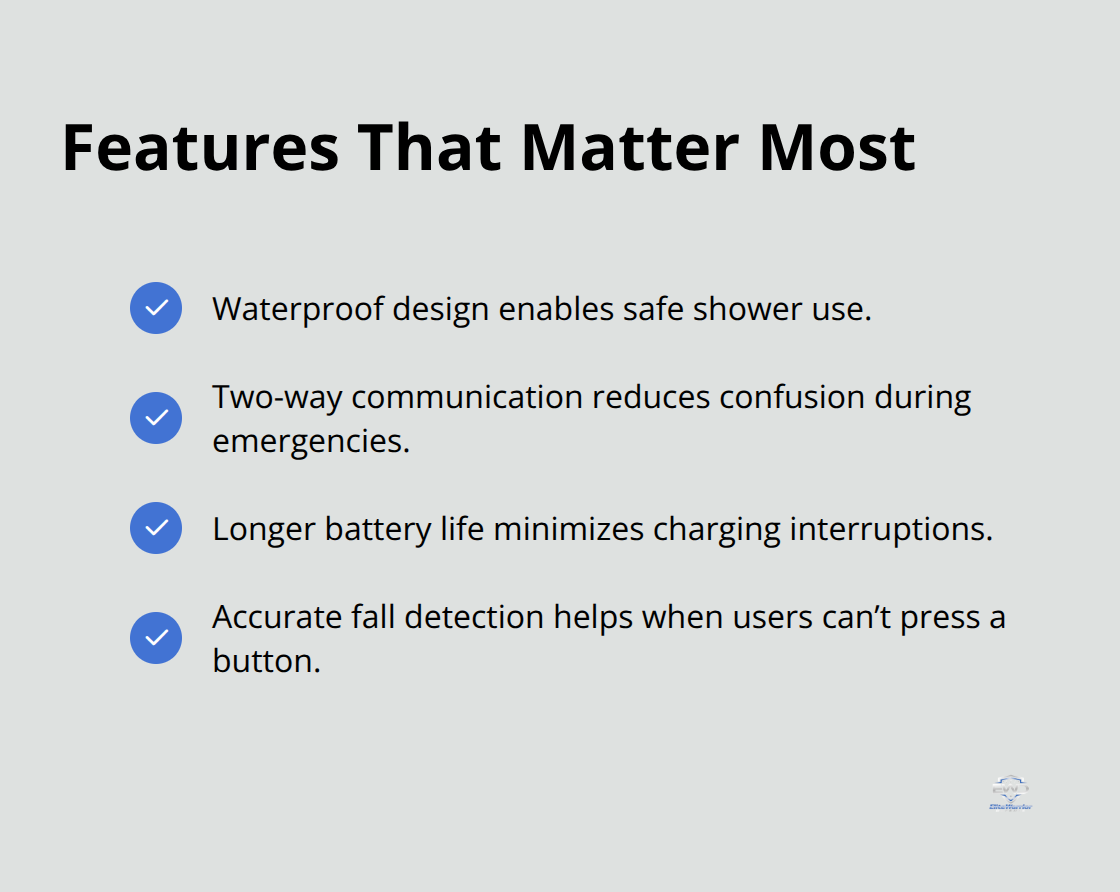Elite Warrior Defense
free shipping on orders over $25
We're having a 15% off sale on all our products. Enter your email below to be notified about future sales.

Every 11 seconds, an older adult visits an emergency room due to a fall-related injury. This alarming statistic highlights why senior safety technology has become more important than ever.
We at Elite Warrior Defense LLC understand that choosing the right panic button system can feel overwhelming with so many options available. The question isn’t whether seniors need emergency response tools, but which solution provides the best protection for their specific lifestyle and needs.
Panic buttons connect seniors directly to emergency monitoring centers through a simple yet sophisticated system. These devices transmit distress signals via cellular networks, landline connections, or Wi-Fi when users press them. Trained operators receive these signals within seconds and assess situations before they dispatch appropriate help.
Modern panic button technology has advanced considerably. Most systems now include automatic fall detection sensors that trigger alerts even when users cannot press buttons manually. This feature addresses the reality that many seniors who fall cannot reach their devices or lose consciousness during emergencies.
Traditional home-based panic buttons connect through existing phone lines or cellular service. These systems provide coverage within a 200 to 1,400-foot range from the base unit, which works well for seniors who spend most time at home and need reliable indoor protection.
Mobile panic buttons offer different advantages. Users wear these devices as pendants or wristbands, and they use GPS technology plus cellular networks to provide location tracking anywhere with cell coverage. Recent data shows approximately 1.4 million people in the UK currently use personal emergency response systems.
Quality monitoring services achieve average response times around 30 seconds, which makes these devices highly effective for emergency situations.
Waterproof design stands out as the most practical feature since it allows seniors to wear panic buttons in the shower. Two-way communication capabilities enable users to speak directly with monitoring center staff, which eliminates confusion about emergency nature.

Battery life varies significantly between models. Some devices last up to 10 days between charges while others require daily power replenishment. Fall detection technology has become increasingly accurate, though false alarms remain problematic with some systems that trigger alerts during normal activities like quick movements from bed.
Monthly fees for panic button systems range from $20 to $60, with additional costs for features like fall detection (typically $10 extra per month). Medicare does not traditionally cover these devices, though some Medicare Advantage plans may provide partial benefits. Health Savings Accounts or Flexible Spending Accounts can help offset these expenses.
Cost barriers affect adoption rates significantly. One in four older Americans avoids medical alert systems due to financial concerns, despite the clear safety benefits these devices provide.
These technical capabilities and cost factors set the foundation for understanding how panic buttons compare to other senior safety solutions available today.
Medical alert systems achieve remarkable response times that save lives. Professional monitoring centers answer distress calls within an average of 29 to 30 seconds, which represents a significant improvement over traditional emergency response methods. Medical Guardian leads the industry with this rapid response capability, while EMT-certified monitoring staff provide informed assistance during actual emergencies.

Real-world data shows impressive results. A study revealed that 92.7% of users reported satisfaction with their panic button systems, and 84.3% found them very important for safety. Research indicates these devices can reduce hospital admissions and emergency department visits, which creates measurable healthcare cost savings. The statistics prove panic buttons work when seniors actually use them consistently.
Panic buttons transform how seniors approach daily activities. Approximately 88% of adults aged 50-80 prioritize staying in their homes as long as possible, and these devices make this goal significantly safer. Users report they feel empowered to participate in social activities they might otherwise avoid due to safety concerns.
The psychological benefits extend beyond physical safety. Many users describe enhanced confidence in routine tasks like showering, gardening, or taking walks. This increased activity level contributes to better overall health outcomes, though the devices cannot replace proper fall prevention strategies or regular exercise programs.
False alarms plague panic button systems more than manufacturers admit. Studies show wildly different emergency activation rates, with one study that found only 2.1% of alarms represented actual emergencies while another indicated 67%. Up to 50% of users report they never activate their devices at all, often due to fear of being a burden or not recognizing serious situations.
Device compliance presents another major hurdle. Research shows 24% of users admit they never wear their pendant, which makes even the most advanced technology useless. The bulk and appearance of some devices deter consistent use, particularly among seniors who value maintaining their appearance and dignity (especially women over 80 who represent the majority of users).
These real-world challenges raise important questions about whether panic buttons alone provide adequate protection, or if seniors need additional safety solutions to address the gaps these devices cannot fill.
Apple Watch dominates the wearable safety market with built-in fall detection and emergency features that more than half of medical alert users now add to their protection systems. The device detects hard falls automatically and contacts emergency services when users cannot respond within 60 seconds. This technology addresses the critical gap where traditional panic buttons fail when seniors lose consciousness or cannot reach their devices.
Smartwatches offer heart rate monitors and step counters that track health patterns throughout the day. These features help identify potential medical issues before they become emergencies, which traditional panic buttons cannot accomplish.
Modern home security systems combine multiple safety technologies through centralized platforms. Ring doorbells and security cameras allow family members to check on seniors remotely, while motion sensors throughout homes detect unusual activity patterns that might indicate medical emergencies or accidents.
Amazon Alexa and Google Home systems enable voice-activated emergency calls without requiring users to press buttons or wear devices. Smart lights automatically illuminate pathways to prevent nighttime falls (a major concern since 1 in 4 older adults report falling every year).
ADT and Vivint now incorporate medical alert features alongside traditional home security, which creates layered protection systems. These services monitor multiple entry points, motion detectors, and emergency buttons through single monitoring centers.
Professional monitoring addresses the reality that many panic button users never activate their devices. Motion detection sensors placed in bedrooms and bathrooms alert family members when seniors haven’t moved for extended periods, which provides passive monitoring without requiring user action.
Medical alert system usage among older adults who need assistance remains low. This reality highlights why combining multiple technologies produces better results than relying on single-point solutions. Caregiver apps available with many systems allow family members to monitor users’ location and status, which provides additional communication layers.

Smart home integration connects devices through centralized platforms that monitor everything from door locks to medication reminders. These systems create comprehensive safety networks that work even when seniors forget to wear or activate individual devices. Personal safety devices can complement these systems by offering additional protection layers beyond traditional panic buttons.
Panic buttons work best when they match individual needs and circumstances. Seniors who spend most time at home benefit from traditional systems with strong base unit coverage, while active seniors need mobile GPS-enabled devices. The 92.7% satisfaction rate among users proves these devices provide real value, but only when people actually wear and use them consistently.
No single safety device addresses every emergency scenario. Panic button systems combined with smart home technology, wearable devices like Apple Watch, and professional monitoring create comprehensive protection networks. This layered approach compensates for the 24% of users who never wear their pendants and addresses the false alarm issues that plague single-device systems.
Cost remains a significant barrier, with monthly fees that range from $20 to $60 plus additional feature costs (though potential healthcare savings from reduced emergency room visits often justify these expenses). We at Elite Warrior Defense LLC understand that personal safety extends beyond medical emergencies to include comprehensive security solutions. Our veteran-owned company offers diverse self-defense and security products that complement medical alert systems for complete protection.